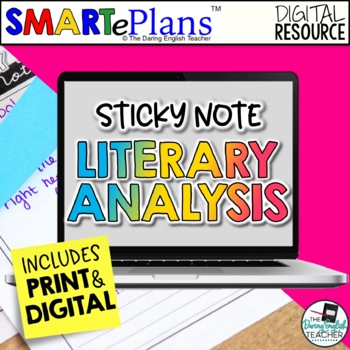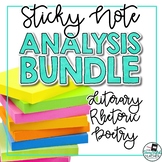Literary Analysis with Sticky Notes: Print and Digital Bundle -Distance Learning
- Zip
- Google Apps™

What educators are saying
Products in this Bundle (2)
Also included in
- Engage your students all year long with analysis sticky note units. You and your students will analyze literature, rhetoric and nonfiction, and poetry.This bundle includes:Literary Analysis with Sticky Notes: Activities, Writing, and PowerPointRhetorical Analysis Unit with Sticky Notes: Activities,Price $47.99Original Price $68.00Save $20.01
Description
This bundle includes the print sticky note literary analysis teaching unit and the new digital version as well.
Digitally engage your students in a literary analysis activity! Increase student engagement and understanding in your next literary analysis unit with digital close reading organizers and scaffolded writing responses that work with any piece of fiction. Students will enjoy using digital sticky notes in class as they analyze complex short stories and novels.
This digital sticky note literary analysis unit runs on the Google platform and is a great way to help students learn to thoroughly analyze literature.
This digital lesson includes:
- an editable, 25-slide Google Slides and PPT presentation for teaching literary devices and short stories
- 15 interactive literary device organizers (Google Slides and PDF)
- 12 writing prompts with outlines
- 1 editable grading rubric
- teacher instructions
- a sample week lesson plan
- suggested stories and paired literary devices
- group brainstorming ideas for digital learning
Literary Devices Included:
- figurative language
- setting
- characterization
- conflict
- symbolism
- motif
- theme
- point-of-view
- mood
- tone
- hero's journey (print only)
This unit includes almost all of the resources you will need for a complete literary analysis unit. You will need to choose and provide the text you read in class to make your own unit come to life. With a little prep work and all of the materials in this unit, you will teach the best short story unit, literary analysis unit, or novel study ever!
SMARTePlans™ is a registered trademark of The Daring English Teacher, Inc. All SMARTePlans units are Google-based teaching units that run on either the Google Slides, Google Docs, or Google Forms platforms. Each SMARTePlans teaching unit is good for a single teacher license. Resources may only be posted online in a secure platform such as Google Classroom™, Canvas, Schoolology, or a similar learning
management system.






